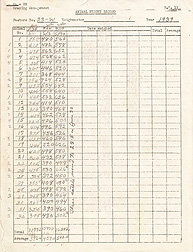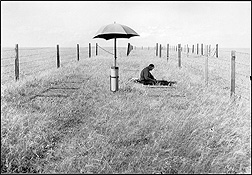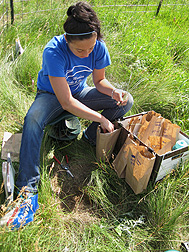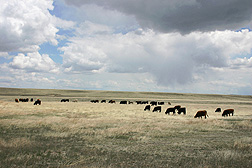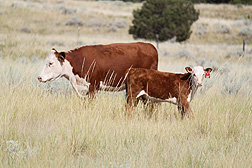Data Analyses Show How Weather Patterns Can Affect Cattle Production
For decades, Agricultural Research Service scientists in the northern plains have kept meticulous records on cattle weight gains during the growing season. Although their main focus was on trends in livestock and forage production, they also tracked weather conditions as part of their studies.
A few years ago, ARS rangeland management specialist Justin Derner assembled a scientific team from three ARS locations in Wyoming, North Dakota, and Montana to study the influence of seasonal weather patterns on cattle production. The team wanted to determine whether past trends could help cattle producers improve management strategies for dealing with future production challenges that might arise from increased seasonal weather variability.
“It’s impossible to answer long-term questions about cattle production using short-term data,” says ecologist Justin Reeves, who works in the ARS Rangeland Resources Research Unit in Cheyenne, Wyoming, and headed up the analyses. “We need a lot of years and a lot of variation in seasonal weather patterns to accurately determine the effect on cattle production.”
The first step was to transfer all the historical written records into electronic databases, a task that took around 2 years. Then, Reeves, Derner, and a team of ARS colleagues began searching for patterns in the long-term data.
|
|
In one of their studies, the team determined the effects of seasonal weather variables on cow-calf production in Cheyenne. The cattle production data they used was taken from records kept from 1975 to 2012 on both Herefords and Red Angus crossbred cattle. The crosses generally outweighed the Herefords and on average produced more beef every year, so the breed groups were studied separately.
The weather variables included spring and summer temperatures, spring and summer precipitation, prior winter precipitation, and prior growing season precipitation. An important factor in the research design was using weather variables that would be easily available to ranchers as forecasts. These same weather variables were used in all the studies, which provided consistency and allowed for results to be compared from location to location.
The scientists found that over the study period, up to two-thirds of the variation in Hereford cattle production could be explained by seasonal weather variations. In addition, Hereford cow-calf pairs were potentially more sensitive to seasonal weather variability than the crossbred animals were. For example, under moderate stocking rates, Hereford cow, calf, and pair beef production increased after wet winters and/or wet springs.
The researchers concluded that wet winters and/or wet springs increased soil moisture levels, which likely helped to support an ample supply of forage for livestock throughout the entire growing season.
|
|
The Case for Stocking Rate
The team also looked at 30 years of data from yearling steers at Cheyenne to determine if seasonal precipitation and temperature affected beef production at light, moderate, and heavy stocking rates.
The researchers determined that cool, wet springs and warm, wet summers increased beef production at moderate and heavy stocking rates, but not at light stocking rates. These seasonal weather conditions enhanced the growth of both cool- and warm-season forage grasses in the region’s northern mixed-grass prairie.
Beef production with light stocking rates was relatively unaffected by seasonal weather variability, because forage was adequate even in years characterized by relatively poor seasonal weather conditions.
The team concluded that seasonal weather forecasts may reduce enterprise risk for ranchers by allowing them to manage forage availability and livestock demand more effectively. This will help ranchers maintain beef production levels and guard against rangeland degradation when conditions are unfavorable for forage growth.
Invasive Grass Arrives
In a third study, the research team looked at data collected at the Northern Great Plains Research Laboratory in Mandan, North Dakota, from 1936 to 2005. The data was collected on yearling Hereford steer production at light and heavy stocking rates, both before and after the native rangeland was invaded by nonnative Kentucky bluegrass in the 1980s. “Kentucky bluegrass invasion is a problem for many reasons in the Dakotas,” Reeves says, “so we wanted to see how the invasion may have affected beef production and its sensitivity to seasonal weather patterns.”
Kentucky bluegrass is a cool-season grass that is most productive in early spring, when temperatures are cool and soil moisture levels are relatively high. When these weather conditions prevail, cattle have earlier and easier access to an abundant supply of forage, which in turn can help boost beef production levels.
The Mandan data suggested that up to three-fourths of the variation in cattle production could be attributed to seasonal weather conditions. Interestingly, cattle production with both light and heavy stocking rates was more sensitive to seasonal weather fluctuations after Kentucky bluegrass arrived. As with the findings from Cheyenne, beef production associated with heavy stocking was more sensitive to seasonal weather variability than beef production with light stocking.
“When you have more cattle, you need more forage,” Derner says. “Any impact that weather is having on forage production—and eventual beef production—becomes more pronounced with heavy stocking rates.”
During the 70-year study period, greater winter and spring precipitation resulted in more beef production with heavy stocking rates. Although spring temperatures did not affect cattle production prior to the appearance of Kentucky bluegrass, after the plant arrived, hotter spring temperatures resulted in a decline in beef production.
|
|
Big-Picture Impact
“The general trends are the same with livestock weight gains at each location, which indicates the relationships we’ve identified between seasonal weather conditions and cattle production are fairly robust,” says Matt Sanderson, research leader at Mandan.
After evaluating their combined results, the researchers concluded that livestock managers can use information about plant communities to determine how projected seasonal weather conditions will affect forage availability—and, by extension, how to adjust cattle stocking rates. This will be particularly useful for producers who periodically want to use heavy stocking rates to optimize profits, since those efforts could be thwarted if seasonal weather conditions end up limiting how much forage is available to meet livestock demands. A long-term goal is to use this information to reduce rancher enterprise risk with the development and dissemination of user-friendly decision-support tools that incorporate free, Web-based, seasonal weather forecasts.
“Our retrospective look at weather variables that have influenced production may begin to help us make projections 10 to 40 years out. This could help cattle producers think about ways they can adapt their production systems to prepare for the impacts of increasing weather variability,” says Derner.
The scientists have published their findings in Rangeland Ecology and Management; Livestock Science; and Agriculture, Ecosystems & Environment.
“There are very few long-term cattle data sets like these, and they are an invaluable resource,” notes Reeves. “ARS scientists had incredible foresight to keep collecting consistent data for so long.”—By Ann Perry, Agricultural Research Service Information Staff.
This research is part of Pasture, Forage, and Rangeland Systems (#215) and Climate Change, Soils, and Emissions (#212), two ARS national programs described at www.nps.ars.usda.gov.
To reach the scientists mentioned in this story, contact Ann Perry, USDA-ARS Information Staff, 5601 Sunnyside Ave., Beltsville MD 20705-5128; (301) 504-1628.
Ecologist Lance Vermeire and animal scientist Mike MacNeil (retired) conducted a related study that used 76 years of data to evaluate links between weather patterns and the growth of Hereford calves at the ARS Fort Keogh Livestock and Range Research Laboratory in Miles City, Montana. Their data was unique; all the animal records were obtained from one closed and pedigree-recorded population that has been maintained at the Miles City location throughout its history.
The scientists found that calves reared in years with longer, cooler growing seasons and typical seasonal precipitation grew faster from birth to weaning than calves reared under other conditions, regardless of previous seasonal precipitation patterns. In the model, they identified two critical weather periods that affected weight from birth to weaning. Additional precipitation from February 8 to February 22—almost certainly in the form of snow—reduced weight gain by nearly 3.4 pounds per 1/10 inch of precipitation. Vermeire and MacNeil think the pregnant cows, which became increasingly wet as the snow accumulated, responded to the wintry conditions with a decrease in body temperature that affected the unborn calves.
During the second critical weather period, from June 23 to July 7, model results indicated that every 1°F increase in temperature reduced growth from birth to weaning by around 1.1 pounds. Since 90 percent of annual plant productivity for this region typically occurs by July, the researchers think the increasing temperatures reduced forage quality by speeding up the rate of plant senescence and reducing forage digestibility and nitrogen content. These results indicated that a general increase in temperature could result in decreased growth in suckling calves in the U.S. northern Great Plains, the scientists say. This research was published in Agricultural Sciences in 2012.
"Data Analyses Show How Weather Patterns Can Affect Cattle Production" was published in the July 2014 issue of Agricultural Research magazine.







